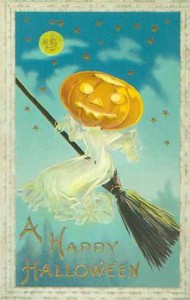Bibles Instead of Candy? Halloween’s Religious History

Many of us know Halloween’s Christian and pagan roots, but did you know some organizations want to reclaim it as a religious holiday sans costumes and—gasp—candy? Matthew Bulger writes on the many religious and secular rituals surrounding the holiday.
Halloween is a magical time full of excited children, sugar rushes, and overworked chaperones that just want to go home and pig out on some leftover candy after guiding their kids around the neighborhood for several exhausting hours. But while the modern Halloween is a secular celebration of king-sized chocolate bars and macabre themes such as witches and skeletons, the day itself has a storied religious history, with details that many people are unaware of.
Halloween is also known as All Hallows’ Eve, and traditionally the day serves serves as the beginning of Hallowmas, the time in the liturgical year dedicated to remembering the dead, including saints and deceased religious believers. Hallowmas is derived from two words: the Old English word halig, meaning saint, and the word mass. Many scholars believe that Hallowmas was created by the Catholic Church when it took a pagan holiday, Samhain, and Christianized it in order to ease the pagans’ conversion to Christianity. Samhain itself is a festival marking the end of the harvest season and the beginning of winter, and it is celebrated by modern pagans and others from sunset on October 31st to sunset on November 1st.
The first day of Hallowmas is All Hallows’ Eve, which is typically celebrated by Roman Catholics who attend a religious service known as the Vigil of All Saints that honors Christian saints and martyrs. This is the day on which the modern Halloween occurs. The second day of Hallowmas is known as All Saints’ Day, which is the day that memorializes “all those who have attained the beatific vision in Heaven.” On All Saints’ Day, many Christians visit graveyards and cemeteries in order to place flowers and candles on the graves of their loved ones, and feasts celebrating their memory are typically held. For Roman Catholics, attending mass is compulsory as All Saints’ Day is a holy day of obligation. The third and final day of Hallowmas is All Souls’ Day, which is also called The Commemoration of All Faithful Departed. This day focuses on honoring all faithful dead Christians, although Roman Catholics are typically the only ones that celebrate it, usually by participating in mass.
While most people have forgotten the Christian and pagan roots of Halloween and the larger religious holiday it is a part of, some are fighting their hardest to restore the religious nature of the holiday and stop what they see as sacrilegious secular celebrations. Some religious advocates have written articles reminding people of the religious nature of the day and encouraging Christians to celebrate it sans costumes, and others have even organized the cringe-inducing “JesusWeen” to celebrate the religious nature of the day. It’s unlikely that many kids will want to pray instead of dressing up and eating candy, but religious activists are sure to keep on trying to reclaim the religious nature of the holiday.
So this Halloween, reflect back on the history of the holiday while celebrating its much more enjoyable modern secular incarnation. And be glad if your kids get a toothbrush from the neighborhood grouch, because they could have gotten a bible instead.
